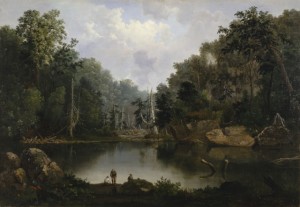![This young whooping crane is on its first fall migration, guided by an Operation Migration ultralight aircraft. Each whooper in this population wears an identification band, and many carry tracking devices that record their movements in detail. [Source:Joe Duff/Operation Migration USA Inc./NPR]](https://www.ghostturtles.com/wp-content/uploads/2013/09/whooping_crane_083013-300x168.jpg)
This young whooping crane is on its first fall migration, guided by an Operation Migration ultralight aircraft. Each whooper in this population wears an identification band, and many carry tracking devices that record their movements in detail. [Source:Joe Duff/Operation Migration USA Inc./NPR]
- Wise Old Whooping Cranes Keep Captive-Bred Fledglings On Track : NPR 083013
Being a wildlife biologist in the 21st century increasingly means rescuing rare animals from extinction. Among the success stories is the whooping crane. Seventy years ago there were only about 16 birds left on the planet. Now there are about 600. But breeding more birds isn’t enough. Scientists want to restore the crane’s way of life, too. And a team of ecologists at the University of Maryland have discovered something that suggests they are succeeding: Captive-bred are picking up tips from older birds about how to skillfully navigate south for the winter. It’s a sign that those whooping cranes are passing knowledge from one generation to the next and, in a sense, rebuilding their culture, scientists Thursday in the journal Science.
- Social Learning of Migratory Performance | Science 30 August 2013: Vol. 341 no. 6149
Successful bird migration can depend on individual learning, social learning, and innate navigation programs. Using 8 years of data on migrating whooping cranes, we were able to partition genetic and socially learned aspects of migration. Specifically, we analyzed data from a reintroduced population wherein all birds were captive bred and artificially trained by ultralight aircraft on their first lifetime migration. For subsequent migrations, in which birds fly individually or in groups but without ultralight escort, we found evidence of long-term social learning, but no effect of genetic relatedness on migratory performance. Social learning from older birds reduced deviations from a straight-line path, with 7 years of experience yielding a 38% improvement in migratory accuracy.
- HawkCount – Whitefish Point, Michigan – 2013 spring migration
- AOU | Birds of North America Online
In two centuries of American ornithology, The Birds of North America (BNA) is only the fourth comprehensive reference covering the life histories of North America’s breeding birds. Following in the footsteps of Wilson, Audubon, and Bent, BNA provides a quantum leap in information beyond what those historic figures were able to assemble. The print version of BNA was completed in 2002 – 18 volumes, 18,000 pages – a joint 10 year project of the AOU, the Cornell Lab of Ornithology, and the Academy of Natural Sciences. Now as an online project of the Cornell Lab of Ornithology, BNA is becoming a living resource. Account contents are updated frequently, with contributions from researchers, citizen scientists, and designated reviewers and editors. In addition, BNA Online contains image and video galleries showing plumages, behaviors, habitat, nests and eggs, and more. And most online BNA accounts now feature recordings of the songs and calls of their species, recordings selected from the extensive collection of Cornell’s Macaulay Library of Natural Sounds. Members of the AOU receive free access to this valuable resource.
- Where The Whale Sharks Go : NPR 082213
Of all the creatures in the sea, one of the most majestic and mysterious is the whale shark. It’s the biggest shark there is, 30 feet or more in length and weighing in at around 10 tons. Among the mysteries is where this mighty fish migrates and where it gives birth. Now scientists have completed the biggest study ever of whale sharks, and they think they have some answers to those questions. The study was conceived by Robert Hueter, a marine biologist at Mote Marine Laboratory in Sarasota, Fla. Hueter swims with sharks, and has done so for 40 years, but he has a special fondness for whale sharks. “This is the largest fish as far as we know that’s ever existed — there’s nothing bigger in the fossil record,” he explains. “But it’s a very unusual kind of shark in that it’s not a top predator; it feeds on plankton.”
- Beatrice the Biologist
Mission: “To make science fun and interesting for the casual reader. I firmly believe that science is important, fascinating, and relevant to every day life, and my goal is to make everyone on the planet agree with that (and pretty much everything else I have to say). I also want to make you laugh.”
- On A Rocky Maine Island, Puffins Are Making A Tenuous Comeback : NPR 082113
Rocky, windswept Eastern Egg Rock, about 6 miles off the coast of Maine, was once a haven for a hugely diverse bird population. But in the 1800s, fishermen decimated the birds’ ranks — for food and for feathers. When ornithologist first visited 40 years ago, the 7-acre island was nearly barren, with only grass and gulls left. Not a puffin in sight. Not even an old puffin bone. “But it had great habitat because there were great boulders on the island, and I could imagine the puffins standing on top of them,” Kress says. No imagination is needed now. Thanks to a relocation experiment pioneered by Kress and his co-workers in the Audubon Society’s , this treeless little island is now kind of a bird tornado.
- Scott Weidensaul – Of a Feather
From the moment Europeans arrived in North America, they were awestruck by a continent awash with birds-great flocks of wild pigeons, prairies teeming with grouse, woodlands alive with brilliantly patterned songbirds. “Of a Feather” traces the colorful origins of American birding: the frontier ornithologists who collected eggs between border skirmishes; the society matrons who organized the first effective conservation movement; and the luminaries with checkered pasts, such as Alexander Wilson (a convicted blackmailer) and the endlessly self-mythologizing John James Audubon. Scott Weidensaul also recounts the explosive growth of modern birding that began when an awkward schoolteacher named Roger Tory Peterson published “A Field Guide to the Birds in 1934.” Today birding counts iPod-wearing teens and obsessive listers among its tens of millions of participants, making what was once an eccentric hobby into something so completely mainstream it’s now (almost) cool.
- Jack Longino, ‘The Astonishing Ant Man,’ Finds 33 New Species : NPR 080113
While many of us spend our working days staring into an electronic box or dozing at meetings, there are some who prefer to crawl through tropical rain forests. People like “the astonishing ant man.” That’s what his students call Jack Longino. Longino started out collecting stamps in his childhood, but that got boring fast. Man-made things just didn’t thrill, so Longino decided to “get small.” As in: “If you’re shopping for a home entertainment system,” he says, “you can’t do better than a good dissecting microscope.” In school, Longino put insects under the microscope, and voila! A new world emerged. “With insects, I kept finding things I could never have imagined,” he said. Like amazing jaws: “These strange sideways mandibles with all the teeth on them,” he says, with wonder still in his now grown-up voice, “and these shield-like faces.” They’re scary, he says, “and they made me think of Hollywood monsters, the creature in Alien and Predator.”
- Researchers find gray wolf-grizzly bear link in Yellowstone – latimes.com 073113
Reintroduction of the gray wolf to Yellowstone National Park has boosted an important food source for the threatened grizzly bear, researchers have found in an example of how the return of a top predator can have far-reaching ecological effects. A study published this week in the Journal of Animal Ecology is essentially a tale of who eats what. When wolves returned to the park in 1995 after a 70-year absence, they preyed on elk herds that browsed on trees and shrubs. The elk population, which had exploded without the wolves, dropped. The over-browsed plants began to rebound, including berry-producing shrubs that provide nutritious summer meals for grizzlies when they are fattening up for hibernation.


![Sandhill cranes land on Platte River sandbar roosts west of Rowe Sanctuary’s Iain Nicolson Audubon Center southwest of Gibbon, Nebraska. [Photo by Lori Porter| Kearney Hub]](https://www.ghostturtles.com/wp-content/uploads/2015/03/sandhill_cranes_kearneyhub_032015-300x225.jpg)
![An endangered Whooping crane takes flight. Yhe large bird has a 7-foot wingspan. It is all white except for black wing tips and face markings. In this photo its long neck stretches forward; its wings sweep upward; and its black legs trail straight behind it. [Source: International Crane Foundation]](https://www.ghostturtles.com/wp-content/uploads/2023/03/Whooping-crane-eastern-ICF-080622-300x157.jpg)

![Mark Willis peruses a 1745 volume by Voltaire at a bouquiniste book stall on the banks of the Seine in Paris. He wears a brown leather jacket and checkered flat cap. He holds the open book in his hands. Rows of old books are seen on shelves behind him. [2005 photo by Ms. Modigliani]](https://www.ghostturtles.com/wp-content/uploads/2023/03/mw_bouquiniste_05-300x225.jpg)


